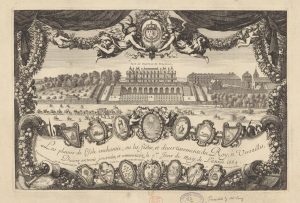
Les Plaisirs de l’Isle enchantée, ou les festes et divertissements du Roy à Versailles, divisez en trois journées et commencez le 7me jour de May, de l’année 1664 (1673)
9 engravings, various sizes
Gift of George Collins Levey 1879
National Gallery of Victoria (p.183.72-1 to p.183.77-1, p.183.81-1, p.183.83-1 and p.183.84-1)
[photo: Title page]
= Levey gift, cat.114-122
These engravings document part of the earliest of several lavish spectacles staged at Versailles in the opening decades of Louis XIV’s reign. Events in each case were orchestrated by the Italian Carlo Vigarini (1637-1713), coordinator of royal spectacles between 1659 and 1690, and publications were issued to record the highlights and disseminate the spectacles to wider audiences.
The engravings, which helped broadcast the magnificence of the French monarchy through a strategy of “theatricality as a strategy of propaganda,” as Thomas Gaehtgens put it recently (in Fuhring 2015), were all published later as vol.11 of the Cabinet du roi, and all were included in the engravings donated to Melbourne by Levey in 1879.
The present group documents the centrepiece of the week-long festivities staged from 7 to 13 May 1664, to mark the commencement of Louis XIV’s building campaign at Versailles, which included the premiere of Molière’s Tartuffe, on 12 May.
Les Plaisirs de l’Isle enchantée, the first collaboration between Molière and Lully, was based on Ariosto’s story (in Orlando Furioso) of the sorceress Alcina holding captive Ruggiero and his companions, later the basis for Handel’s opera Alcina. The 4th plate represents, as the inscription indicates, Louis XIV and his courtiers playing the roles of Ruggiero and his enchanted knights. A ballet on the theme of the Seasons was presented on the evening of the first day (Plate 5). The second evening saw the performance, on an outdoor stage, of a ballet by Molière and Lully entitled La Princesse d’Elide (Plate 7). The event reached its climax on the third day, with the appearance of Alcina and her servants on three floating sea-monsters, the breaking of the spell binding Ruggiero, the conflagration of Alcina’s palace, and a spectacular fireworks display (Plates 8-9).
Silvestre’s engravings were published, with a text by Félibien, in 1673. In sequence, the individual prints are as follows (details and reproductions in the NGV’s online catalogue):
Title page: Les Plaisirs de l’Isle enchantée, ou les festes… May, de l’année 1664 [Levey gift, cat.114]
Plate 2: Premiere Journée – Marche du Roi, et de ses Chevaliers [Levey gift, cat.115]
Plate 3: Premiere Journée – Comparse du Roi, et de ses Chevaliers [Levey gift, cat.116]
Plate 4: Premiere Journée – Course de bague dispute par le Roy… [Levey gift, cat.117]
Plate 5: Premiere Journée – Comparse des quatre Saisons… [Levey gift, cat.118]
Plate 6:Premiere Journée – Festin du Roy, et des Reynes… [Levey gift, cat.119]
Plate 7: Seconde Journée – Theatre fait dans la mesme allée…[Levey gift, cat.120]
Plate 8: Troisieme Journée – Theatre dressé au milieu du grand Estang… [Levey gift, cat.121]
Plate 9: Troisieme Journée – Rupture du Palais… [Levey gift, cat.122]
Refs.
Not listed in NGV 1894 or 1905
All 9 prints are identified and reproduced in the NGV catalogue. Cf. Suite et Arrangement (1727), p.15; Duplessis Cabinet du roi (1869), pp.4 and 12, noting the 1673 publication
See also Fuhring A Kingdom of Images 2015), pp.5-6 (Thomas Gaehtgens, as cited above), and 262-5 (Louis Marchesano: “Events”), including a reproduction of the final plate of this series on p.264
